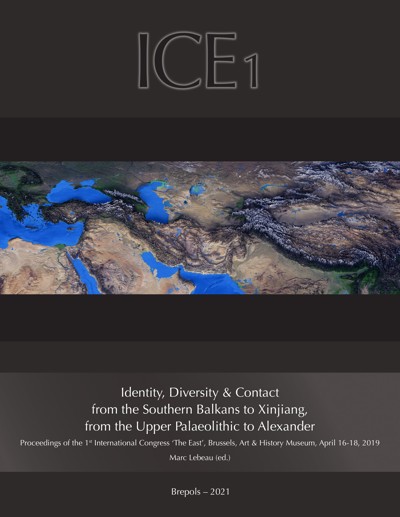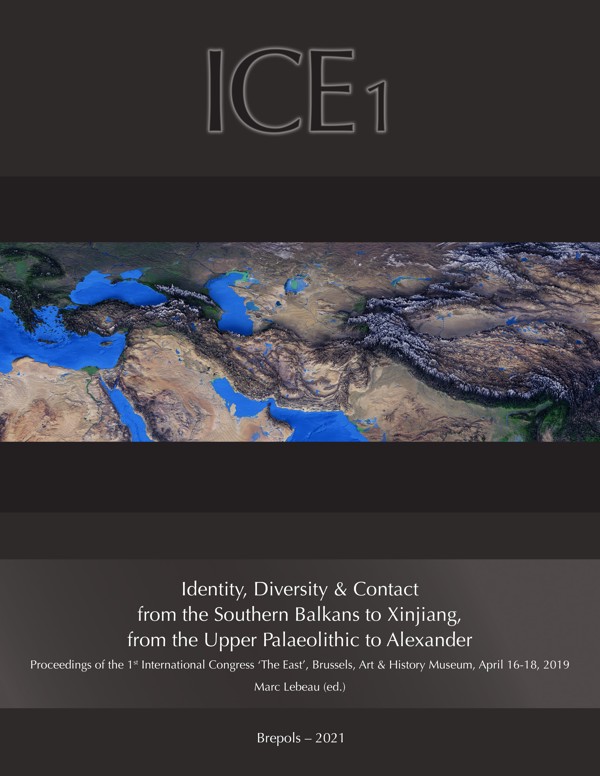Identity, Diversity & Contact
from the Southern Balkans to Xinjiang, from the Upper Palaeolithic to Alexander
Marc Lebeau (ed)
- Pages: xvi + 360 p.
- Size:216 x 280 mm
- Illustrations:130 b/w, 18 col., 8 tables b/w., 17 maps b/w, 3 maps color
- Language(s):English
- Publication Year:2021
- € 100,00 EXCL. VAT RETAIL PRICE
- ISBN: 978-2-503-58949-7
- Paperback
- Available
This volume presents peer-reviewed contributions based on papers first presented at the biennial International Congress ‘The East’ (ICE). Dedicated to the archaeology and history of a region that spans from the Southern Balkans and the Eastern Mediterranean, via the Near and Middle East, the Persian Gulf, and the Caucasus, across to Central Asia, Pakistan, and Xinjiang, the ICE series encourages the publication of research that cuts across not just geographical and chronological boundaries, but also the borders that exist between disciplines. The first ICE Conference chose as its theme ‘Identity, Diversity, and Contact’, and the papers drawn together in this volume comprise several sub-topics, including evolution and resilience, movement, mobility, and migration, long distance and the longue durée, and cultural and economic contacts.
The East Collection and the International Congress ICE 1 — The East: An Introduction — MARC LEBEAU
A Closer Look at the Anatolian Prehistoric Arts — MARCEL OTTE
The Dispersal of Pressure Débitage Technology to Central and Southwest Asia — YOSHIHIRO NISHIAKI
Bronze Age Oases in the Tarim Basin (Xinjiang, China): Identities, Early Contacts and Interaction Networks (3rd-2nd mill. BC) — CORINNE DEBAINE-FRANCFORT
The Neolithisation of Central Asia: Emergence of Cultural Identities and Long-Distance Networks — FRÉDÉRIQUE BRUNET
Pazyryk in its Landscape Setting: The Materials and Materiality of Cultural Contact — KAREN S. RUBINSON & KATHERYN M. LINDUFF
When East and West First Met: The Nature of Cultural and Technological Transmissions at the Dawn of the Silk Roads — ALISON BETTS, PETER JIA, MICHAEL SPATE, QI MENG & MUMTAZ YATOO
Made in Indus, Made in Oman, and Made in Susiana: Meluhha and Makkan at Kish, Telloh, and Susa as seen from Weights and Ingots — ENRICO ASCALONE
Migrations, Transfers, Exchanges, Convergences? Assessing Similarities and Differences among the Earliest Farmers between the Daulatabad and Kachi Plains (southern Iran and Pakistan) — BENJAMIN MUTIN & OMRAN GARAZHIAN
The Human Remains from the Collective Iron-Age Burial ff Hatsarat (Armenia) — FRANCESCA BERTOLDI, RUZAN MKRTCHYAN, ASHOT PILIPOSYAN, PIERA ALLEGRA RASIA, ROBERTO CAMERIERE & HASMIK SIMONYAN
The Crown of Death: Diadems with Repoussé Decoration in the Early Bronze Age — VITTORIA DALL'ARMELLINA
Fortified Kura-Araxes Settlements in the Highlands of Eastern Anatolia: Lake Van Basin and Mt Ağrı —AYNUR ÖZFIRAT
In the Pre-Urartian Period, Were the Societies of the Eastern Anatolian Highlands Egalitarian? A General Review — MEHMET IŞIKLI
Road Connections of the Second Millennium BC that Connect the Coastal Region of Giresun to Lycus Basin — SALIH KAYMAKÇI
Figurines with Coffee-bean-eyes from the Khabur and Beyond: Significance of an Iconographic Detail — ALEXANDER PRUß
A Ceramic Tale of Three ‘oikumenai’ from the Qara Dag Area (Iraqi Kurdistan) — JOHNNY SAMUELE BALDI & MELANIA ZINGARELLO
Provincial Identity via Middle Assyrian Mortuary Material — PETRA M. CREAMER
Is the Luwian Language an Ethnic or a Cultural Marker in Iron Age Syria? — GUY BUNNENS
Oluz Höyük: Persian (Achaemenid) Settlement in North-central Anatolia — ŞEVKET DÖNMEZ & MONA SABA
The Role of Syria in Inter-Regional Exchanges in the Second Half of the Third Millennium BC: Some Remarks — MARIA GIOVANNA BIGA
On the Origin of Near Eastern Cylinder Seals in the Early Bronze Age Aegean: New Evidence from the Northern and Central Levantine Coast — HERMANN GENZ
Emerging Complexity: The East Aegean/Western Anatolia and Crete in the Middle Bronze Age (c. 2000–1700 BCE) — OURANIA KOUKA
Hittites and Neo-Hittites in Northern Syria: New Perspectives for their Interrelations — WINFRIED ORTHMANN

